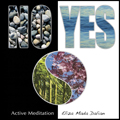We all know that regular exercise is essential for our physical health but we often forget that meditation is essential for our mental, emotional, and spiritual health. Meditation gives us an opportunity to disidentify from our mind chatter and negative emotions and experience inner balance. It allows us to free ourselves from fear and suffering created by our ego-mind. A dedicated meditation practice can lead to increased self-acceptance, self-confidence, improved health, and deeper understanding of ourselves and others.
What is Meditation?
The essence of meditation is a detached observation or witnessing of whatever happens inside (the body, mind, and emotions) and outside (the world around you) without reaction or judgment. Through learning to observe you stop fueling your desires, thoughts and emotions and settle your awareness in the silent stillness of your being.
Passive Verses Active Meditation
At their core, there is no difference between active and passive meditations. Their intent is the same – to empty the mind and help you connect with and strengthen your inner witness.
Traditionally, meditation has been practiced through passive sitting and watching the breath, body, and mind. This meditation technique is known as Vipassana and was devised by the Buddha 2,500 years ago. Passive sitting and observation was much easier to practice in Buddha’s time because people lived closer to nature and were more relaxed and heart-centered than we are today.
Our modern lifestyle is dramatically different. We function at a much higher speed and are overwhelmed with information overload. We are bombarded with electromagnetic waves that undermine out immune system, and advertising that feeds our desire for material things. We have a poor diet, lack sleep and our stress levels are very high. When we are faced with this increasingly fast-paced lifestyle and are preoccupied with worries and aches and pains, quieting the mind through passive sitting becomes a monumental task that very few are able to achieve.
The quickest way to relax and experience a peaceful meditative state of pure consciousness in this day and age is through Active Meditation. Many people find Active Meditations easier and more enjoyable to practice because they help to quickly release accumulated stress from the body and mind, and allow even the busiest minds to experience silent gaps of inner peace with much less effort.
What is Active Meditation?
Active Meditation is an evolutionary process of releasing our stress and pent up emotions from the body while simultaneously being engaged in witnessing and dis-identifying from our thoughts and emotions.
There are several evolutionary Active Meditation techniques devised by the Indian mystic Osho for the contemporary man and woman. They have been practiced by millions of people around the globe since the mid 1970’s with outstanding results. These meditation techniques aid the modern-day seeker to experience inner silence and stillness a lot faster than what can be achieved through a long practice of passive sitting.
The Osho Active Meditations incorporate a sequence of four to five stages and come with pre-recorded CDs, which help the meditator to playfully transition from one stage to the next. While practicing them, you can laugh, cry, jump, shake, run, hum, shout, dance, and be free to express whatever you have been suppressing. Once the repressed thoughts and emotions are released, it becomes much easier to become conscious of and experience peace and no-mind in the silent sitting phase of the meditation.
The benefits of Active Meditation
Active Meditation will help you:
• detoxify your body of pent up thoughts and emotions
• relax and heal physical pain
• improve digestion and lose weight
• heal mental and emotional wounds
• transform fear and anxiety and experience inner peace
• gain self-confidence and uncover your inner strength
• achieve a deeper understanding of yourself and others
5 of the Most Practiced Active Meditation Techniques
Below is a list of 5 favorite Active Meditation Techniques practiced around the world:
Dynamic Meditation by Osho
Nadabrahma by Osho
Chakra Breathing by Osho
No-Yes Active Meditation by Eliza Mada Dalian
It is best is to experiment with all of these meditation techniques and choose a couple that you find most enjoyable to practice with on a regular bases. Even if you choose only one meditation technique, but do it regularly (at least once or twice a week) you will be rewarded with powerful transformation in your personal, spiritual, and work life.






